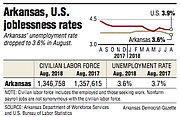Arkansas' unemployment rate fell to 3.6 percent in August from 3.7 percent in July and tied the state's historical low, the U.S. Bureau of Labor Statistics said Friday.
The national unemployment rate was 3.9 percent.
The unemployment rate in Arkansas was 3.6 percent from February through May last year.
Since 1957, as far back as data is available, Arkansas' unemployment rate has not been lower than 3.6 percent, a spokesman with the bureau said.
Unemployment data was published only in annual reports to the president from 1957 to 1975 and those reports included only annual unemployment rates for the states, the spokesman said. From 1976 to the present, the bureau has reported monthly rates for each state, the spokesman said.
Seemingly a positive report for Arkansas, the low rate happened for the wrong reason, economists said.
The 3.6 percent rate was driven by substantial declines in the number of unemployed over the past two months, said Michael Pakko, chief economist at the Arkansas Economic Development Institute at the University of Arkansas at Little Rock.
The number of unemployed declined almost 1,420 from July to August and about 1,300 from June to July, Pakko said.
"Over the past 12 months there has been a cumulative decline of 8,600 in the number of employed" Arkansans, Pakko said.
The decline in employed and unemployed caused the labor force to fall by nearly 1,700 from July to August.
The labor force includes the employed and those seeking work.
"Since December, the labor force has dropped exactly 0.1 percent every single month through August," said Mervin Jebaraj, director of the Center for Business and Economic Research at the University of Arkansas, Fayetteville. "It stands to reason that all those people left the labor force as opposed to finding jobs."
In contrast, the labor force and the number of employed and unemployed grew in February to May last year when the unemployment rate also was 3.6 percent, Jebaraj said.
"What we're looking at is an extended period this year where the unemployment rate is dropping with people dropping out of the labor force and not because we're adding jobs at any meaningful sense," Jebaraj said.
As has been the case for much of the year, the two monthly surveys that the Bureau of Labor Statistics uses to calculate the labor force and nonfarm labor jobs are giving different signals about the state's economic health.
The payroll survey involves a poll of thousands of employers who are asked about the size of their workforce. The size of the labor force and the unemployment rate are determined by a survey of about 800 households in the state.
"In the six months ending in August, the payroll report shows an increase of 0.6 percent while the household survey shows a 0.3 percent decline," Pakko said.
Of the two measures, the payroll survey is generally considered to be more accurate, although both will be subject to revision early next year, Pakko said.
"If you put a gun to my head and asked me which one would I choose as the most likely to be correct, I would say it would be the payroll survey is more likely to be correct," Pakko said. "At least we're seeing some modest but positive growth there and that is probably the best indicator of what is actually going on."
Arkansas was among 45 states that recorded an increase in construction jobs from August 2017 to last month, the Associated General Contractors of America said. Arkansas added 1,900 construction jobs over the 12-months.
But Arkansas was one of 15 states to report a decline in construction jobs from July to August, the contractors said. Arkansas lost 100 jobs for the one-month period.
"These results show that contractors still expect to have plenty of work in the months ahead," said Ken Simonson, the contractors' chief economist. The question many in the industry are asking is whether they will be able to find enough workers to keep pace with demand."
Arkansas had job gains in six nonfarm payroll sectors in August compared with August 2017 and losses in five sectors.
The biggest increase was the professional and business services sector, which added 6,000 jobs. But most of those were lower-paying temporary jobs, Jebaraj said.
Greg Kaza, executive director of the Arkansas Policy Foundation in Little Rock, noted that despite the record low unemployment rate, job changes from July to August were disappointing.
Seven of the 11 sectors lost jobs for the one-month period and two others were flat, Kaza said.
The educational and health services sector and government recorded job gains.
There were job declines in construction; manufacturing; trade, transportation and utilities; information; financial activities; professional and business services; and leisure and hospitality, Kaza said.
The mining and logging sector and "other services" were flat.
Hawaii had the lowest unemployment rate in August at 2.1 percent, followed by Iowa at 2.5 percent, North Dakota at 2.6 percent, New Hampshire at 2.7 percent and three tied at 2.8 percent -- Idaho, Nebraska and Vermont.
Alaska had the highest unemployment rate at 6.7 percent, followed by West Virginia at 5.3 percent, Louisiana at 5 percent, Mississippi at 4.8 percent and three tied at 4.6 percent -- Arizona, New Mexico and Ohio.
Business on 09/22/2018
